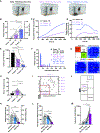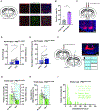Toggling between food-seeking and self-preservation behaviors via hypothalamic response networks
- PMID: 37442130
- PMCID: PMC10528369
- DOI: 10.1016/j.neuron.2023.06.006
Toggling between food-seeking and self-preservation behaviors via hypothalamic response networks
Abstract
Motivated behaviors are often studied in isolation to assess labeled lines of neural connections underlying innate actions. However, in nature, multiple systems compete for expression of goal-directed behaviors via complex neural networks. Here, we examined flexible survival decisions in animals tasked with food seeking under predation threat. We found that predator exposure rapidly induced physiological, neuronal, and behavioral adaptations in mice highlighted by reduced food seeking and consumption contingent on current threat level. Diminishing conflict via internal state or external environment perturbations shifted feeding strategies. Predator introduction and/or selective manipulation of danger-responsive cholecystokinin (Cck) cells of the dorsal premammilary nucleus (PMd) suppressed hunger-sensitive Agouti-related peptide (AgRP) neurons, providing a mechanism for threat-evoked hypophagia. Increased caloric need enhanced food seeking under duress through AgRP pathways to the bed nucleus of the stria terminalis (BNST) and/or lateral hypothalamus (LH). Our results suggest oscillating interactions between systems underlying self-preservation and food seeking to promote optimal behavior.
Keywords: calcium imaging; cell-specific perturbation; chemogenetics; choice; conflict behavior; feeding; foraging; in vivo neural activity recordings; optogenetics; self-preservation.
Published by Elsevier Inc.
Conflict of interest statement
Declaration of interests The authors declare no competing interests.
Figures







References
Publication types
MeSH terms
Substances
Grants and funding
LinkOut - more resources
Full Text Sources
Molecular Biology Databases

